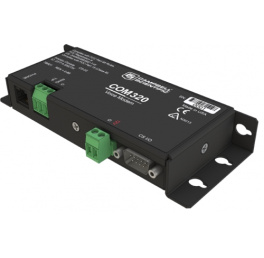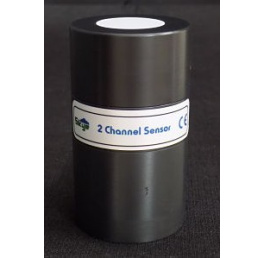The RF451 is a powerful 900 MHz point-to-multipoint serial radio that is well suited for wireless networking with PakBus data loggers that are located miles apart. The RF451 is a 902 to 928 MHz frequency-hopping spread-spectrum radio. The radio features high noise immunity, fast serial data transfer speeds, and the maximum transmit power allowed by the FCC in an effort to provide reliable, hassle-free operation.
Constructing a network using RF451 radios is a simple, easy-to-do configuration process. To construct a network, connect one radio to a PC and configure it as the master radio. Then connect a second radio to a data logger. The link can be treated as a high-speed, multi-drop serial connection.
The RF451 is a frequency-hopping spread-spectrum radio, capable of operating between 902 to 928 MHz and transmitting with up to 1 Watt (30 dBm). The specific frequencies used may be selected when operating outside the US and Canada to meet local regulations. Additionally, the RF power output may be adjusted to as low as 10 mW via software.
Typical communication distances are greater than 4 miles with up to 60 miles achievable under ideal conditions. Extended communication distances are possible using repeaters.
The operating frequency band of this radio modem may be shared with other non-licensed services such as cordless telephones and with licensed services including emergency broadcast and air-traffic control.
The RF451 consists of a radio module manufactured by FreeWave Technologies and a Campbell Scientific interface board. It reduces susceptibility to RF interference from other spread-spectrum devices by providing user-selectable frequency hopping patterns. Spread-spectrum radios spread the normally narrowband information signal over a relatively wide band of frequencies. This process allows communications to be more immune to noise and other interference.
RF451 radios, like all FCC Part 15 devices, are not allowed to cause harmful interference to licensed radio communications and must accept any interference that they receive. Most Campbell Scientific users operate in open or remote locations where interference is unlikely. If there is a problem, interference can be reduced using methods such as moving the device, reorienting or using a different type of antenna, or adding RF shielding.
Powering the Radio
At least two radios are required to create a link. The radio may be powered through the dc barrel connector or via a CS I/O connection. When ac power is available, the 15966 wall charger is commonly used. At remote sites, the RF451 typically is powered through the CS I/O or the 14291 field cable.
Antennas
Campbell Scientific offers a variety of antennas for this radio. The 14204 is a 0 dBd, 1/2 wave omnidirectional whip antenna that connects directly to the radio (no cable required) and can transmit short distances (up to 1 mile). The 15970 dipole antenna includes adhesive for window or wall mounting and a cable for connecting to the radio.
Our higher gain 14221 omnidirectional and 14205 Yagi antennas require a cable to connect them to the radio. The 31314 surge protector is available for radios susceptible to lightning or electrostatic buildup or when the cable length needs to be longer than 3 m (10 ft), as measured between the transceiver and the antenna.
| Radio Type | Frequency Hopping Spread Spectrum (FHSS) |
| Frequency | 902 to 928 MHz |
| Country Used In | US, Canada, Australia |
| Power Output | 10 to 1,000 mW (user-selectable) |
| Transmission Distance |
|
| Modulation | 2 level GFSK |
| RF Data Rate | 115.2 or 153.6 kbps (selectable speeds) |
| Occupied Bandwidth | 142 kHz (applicable to FCC ID KNYAMM0921TT) |
| Hopping Patterns | 15 per band, 105 total (user-selectable) |
| Hopping Channels | 50 to 111 (user-selectable) applicable to FCC ID KNYAMM0921TT |
| Frequency Zones | 16 |
| Receiver Sensitivity |
|
| IF Selectivity | 40 dB (at fc ± 230 kHz) |
| Receiver Selectivity | 50 dB (at 896 MHz, 935 MHz) |
| Error Detection | 32-bit CRC (retransmit on error) |
| Data Encryption | proprietary spread-spectrum technology |
| Link Throughput | 115.2 kbps (maximum) |
| RF Connector | Reverse Polarity SMA (RPSMA) jack (external antenna required) |
| CS I/O | DB9 M, SDC 7/8/10/11 device |
| RS-232 | DB9 F, DCE |
Power
| Input Voltage | 7 to 28 Vdc |
| Powered Over | CS I/O or barrel plug |
| Connector | Barrel plug, center positive 12 V (used to connect the 14291 Field Power Cable or 15966 ac adapter) |
USB
| -NOTE- | Used for connection to computer for network communications or device configuration. Does not supply enough power for normal operation; RF451 must be powered through dc barrel plug or CS I/O. |
| Type | USB standard B (device only) |

















